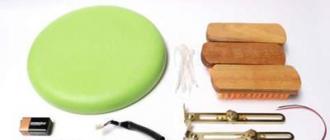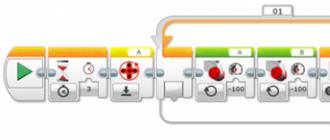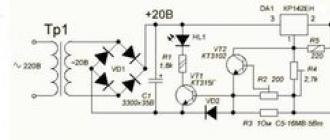Style- This is a collection of formatting options that has its own name.
In order for the text to be easy to read, it must be formatted accordingly: select headings, arrange subheadings in accordance with their level, make captions for figures and tables, highlight new terms, notes, set headers and footers, etc. Format each of the elements manually long and inefficient. With styles, you can set multiple formatting options in one step. At the same time, for each of the design elements, you can set your own style, which will have a unique name. It is enough to set the required styles, and then each time just select the required one from the list.
Using styles can improve efficiency and speed up work.
In MS Word, a style can be applied to an entire paragraph or to multiple characters.
The default style is set to Normal . This style is applied to the body text of any document and serves as the basis for creating other styles. Formatting options can be found in the style description contained in the dialog boxes. Style, Style change, Style creation, Organizer. All of the dialog boxes listed above contain a section Description, which represents all the format options.
Setting Styles
The dialog box provides the widest possibilities for working with styles. Style. To set a style using a dialog box Style you need to do the following:
1. Position the cursor within the text fragment in which you want to change the style.
2. Choose a team Format –> Style. A dialog box will open Style(Fig. 4.28).
3. Listed Style select the desired style.
4. Press the button Apply.
Using the dialog box Style you can also:
- modify existing styles;
- create new styles;
- delete custom styles that have become unnecessary;
- copy the required styles from one template to another.
Rice. 4.28. Dialog window Style.
Headings rarely include headings of all levels. A table of contents containing the names of all parts of the document can look too cumbersome. On the other hand, a table of contents containing only top-level headings provides too little information about the content of the document.
To create a table of contents, follow these steps:
1. Place the cursor within the text in which you want to create a table of contents.
2. Choose a team Insert –> Table of Contents and Indexes. A dialog box will open Table of contents and indexes(Fig. 4.29).
3. Go to tab Table of contents.
4. In the field Format select a way to present the table of contents, in the field Levels - the level of headers to include, and in the field placeholder - padding characters between headings and page numbers.
5. Press the button OK.

Rice. 4.29. Inclusion in the table of contents for levels 1-3
After pressing the button OK a layout of the table of contents will appear on the screen, which you can later modify and format.

Rice. 4.30. Ready-made table of contents, including headings of three levels
Auto Format
Auto Format can format the document without user intervention. MS Word analyzes the document, identifies individual elements, and then formats the text using the styles of the attached template.
Auto-formatting can be performed both as you enter text, and after you enter it. In this case, the user reserves the right to accept or reject the formatting made using autoformat. In addition, you can partially accept, and part of the changes made - to refuse.
Using "Styles" in Microsoft Word can automate document formatting and save you time, which will greatly affect your productivity while working with documents. If you want to learn quick format text, then follow the basic steps below.
Step 1. Apply styles to sections of unformatted documents.
Sometimes text or a section of text in a document may not look the way you want, and in order to transform it, you need to select the desired fragment, go to the "Styles" menu and select the desired style to apply.
Step 2: Quickly Modify an Existing Style
Step 3. Create a table of contents with styles
When writing multi-section scientific articles or book chapters, you may need to use tables of contents, which in this case are important, as they help in navigating the contents of the document.
To set the table of contents, do the following:
- Place the cursor on the part of the document where you want to place the table of contents.
- Click the Links tab, then click Table of Contents.
- Pay attention to the dialog box that appears. The "Auto-assembled TOC 1, 2" options will speed up the creation process. "Manual Table of Contents" makes it possible detailed settings but it will take longer to install.
- Check out the "Custom Table of Contents" option. Once selected, you can use styles to change how the table of contents is displayed by clicking Edit.
- If your table of contents has multiple levels, select the one you want to change.
- You will then see the dialog box used when changing the style. Change the specifications if necessary, then click OK.
As you can see, working with text or styles can save time. You only need to make changes to the "Styles" or "Tables" once and then use it as a template, applying it to the necessary fragments of text or the whole document.
Video: Formatting a document in MS Word 2003. Working with styles
Practical lesson number 3. Style formatting using text Microsoft editor Word
Purpose: to gain practical skills in creating and using styles in the development of text documents.
Style formatting
The concept of style in a text document
To draw the reader's attention to certain parts of the text (words, sentences, paragraphs), formatting is used to make the text expressive and readable - highlighting text objects by changing some of their parameters.
When working on a document, formatting can be done manually, or you can use styles.
When formatting manually, the user uses the basic "select text and change options" technique. If the changes do not suit you, you must repeat the reception. Sometimes you have to spend enough time to find an acceptable (from the user's point of view) combination of text parameters.
Using styles allows you to automate the process of selecting the optimal parameter values.
I must say that the term "style" in the Word environment has a slightly different meaning than the commonly used one. AT explanatory dictionary Russian language S.I. Ozhegov, the following interpretation is given: "Style is a characteristic look, a kind of something, expressed in special features, properties of decoration." So, for example, when we talk about the style of clothes, we mean a special cut developed by a designer, a special fabric, as well as the use of harmoniously matched accessories. Style in painting implies a certain way of applying strokes, using colors, ways of artistic transmission of the image.
Style in a text document is a more utilitarian concept.
Style– a set of values of text parameters predefined and saved with a certain name.
When a style is applied to text, all parameter values described in the style are applied at the same time. Thus, applying a style replaces the manual operation of setting parameter values using buttons, menus, and dialog boxes and significantly reduces work time.
Style formatting - creating and applying styles to objects in a text document. The meaning of this operation is as follows. First, a style is created for certain objects, which is then applied to format the objects in the text document. If you need to change the values of object parameters, just change the style. In this case, all objects that are assigned the same style are automatically reformatted.
When formatting a multipage document, styles are used to format paragraphs of the main text, for headings, to highlight individual words, definitions, lists, tables. Typically, the user applies some limited set of styles for formatting.
You can create styles yourself, or you can use the ready-made styles available in the Word environment. Enough is built into the Word environment big list styles for different purposes. The created or modified style can be included in the document template, then it will be available for use in any document. If the style is not included in the template, then it will be stored only in this document.
At the beginning of mastering the technology of style formatting, it is enough to apply ready-made styles and change their settings as you wish.
You can view the list of styles available in the Word environment using the Styles group on the Home tab (Fig. 1).
Rice. 1. Styles group on the Home tab
The group displays buttons of the so-called quick styles, which, according to the developers, are most often used in documents. The concept of a quick style (as well as the concept of a quick block was introduced by developers starting with the version of Word 2007).
The Change Styles button allows you to completely reformat a document using a specially designed set of styles. The list contains several sets of styles offered by developers. However, they are not suitable for the Russian practice of preparing documents.
To view a list of all styles, use the Styles button in the lower right corner, which opens the Styles window. In the window, you can open a list of styles and formatting elements of the document.
Types of styles
While formatting a document, the environment remembers all types of formatting, both stylistic and manual, that the user has applied.
To view a list of all styles, as well as manual formatting in a document, on the Home tab in the Styles group, click the Styles button. A dialog box will open on the right (Fig. 2). This window contains a list of styles that can be applied to the document. If you check the Preview checkbox, then the names in the list will be written in the appropriate format (Fig. 2), because you can immediately see how the formatted text will look. This is how the list of styles was displayed in previous versions word. On the right, next to the style name, you see an icon that indicates the type of style.


Rice. 2. Dialog box Styles in two display options
There are three types of styles in Word 2007:
Paragraph style (). Applies only to the whole paragraph and completely determines its appearance, namely the settings for character parameters (font type, style, size, color, etc.) and the paragraph (text alignment, tab positions, line spacing and borders, etc.). It is not necessary to select a paragraph to apply the style, it is enough that the cursor is inside the paragraph. Paragraph Style Examples - Normal, Heading 1, Heading 2 (total 9 heading styles), bulleted list(5 styles), Numbered List (5 styles).
Sign style (). Applies to the selected piece of text. Sets the formatting of a selected text fragment within a paragraph, defining only character parameters, such as font type and size, style, etc. An example of a character style is Highlight, HTML Definition.
Style related (character and paragraph) (). Applies either to a piece of text, or to an entire paragraph if no piece is selected. The style describes character and paragraph settings. Only the described character parameters are applied to the selected fragment, and the entire set of parameters is applied to the whole paragraph. Examples of related style are Date, Body Text, Greeting.
In addition, Word has built-in list styles and table styles. They can be applied when creating the corresponding document objects. You can also create list styles and table styles. List and table styles are not displayed in the Styles window.
The Styles window is also convenient because, in addition to styles, it allows you to display the usual manual formatting used in the document. To set up the style area, click on the Options hyperlink (Fig. 2). The Style Area Settings window will open (Fig. 3).

Rice. 3
In the Displayed styles field, set one of the options: Recommended, Used, In current document, All. You can set the sort order of the style list.
To also display manual formatting in the styles area, you must enable the checkboxes Paragraph formatting, Text formatting, List formatting.
As already mentioned, styles of a certain kind are marked with a special icon. It is indicated next to the style name. If manual formatting is applied, then the formatting elements will be described in the line and there will be no icon. When you hover over a line, a context tooltip appears with full description formatting. The table (Table 2) shows examples of displaying formatting in the style area.
Table 2. Description of formatting in the Used list
Most paragraph styles are based on the Normal style, which is called the base style.
Some styles, although they exist in the document, do not appear in the list. This mainly concerns the styles of automatically created objects, for example, the footnote mark, the main paragraph font, table of contents styles, and some others.
To view full list styles, select All in the Displayed styles field (Fig. 3).
By default, text in a new document is entered using the Normal style.
Style formatting includes the following operations
Applying an inline style.
Change inline style.
Create a style based on a selection.
Creating a new style.
Add styles to and remove styles from the Quick Styles list.
Style Formatting Technology
What is "style formatting"?
Style formatting is the formatting of text using styles. If you set the desired style for a paragraph, the editor will automatically format it by setting a specific font, paragraph characteristics, language, framing, numbering, etc. Secondly, if you later change the characteristics of the style, then the corresponding characteristics for all paragraphs with this style will also automatically change. That. greatly simplifies the change process appearance a multi-page document in accordance with a given standard (for example, a thesis or a scientific article).
There are a large number of styles in the Word text editor, but styles are mainly used:
Þ Heading 1 - for chapter titles.
Þ Heading 2 - for titles of paragraphs
Þ Normal - for plain text
Þ Footnote text - to define footnotes.
How to set the desired style?
There are two ways to set the desired style. First, you need to place the cursor on the desired paragraph. Secondly, you can set the desired style from the drop-down list in the toolbar or select the Style command in the Format submenu and specify the required style in the dialog box.
Why are templates needed?
A template is a style library. There are a large number of templates. For example, Normal (used by default for all newly created templates), Thesis, Brochure, etc.
Templates allow you to use the same style in different text documents. If you create a new document with the "New" command from the "File" submenu, the editor will prompt you to select a template for your document. Usually choose standard pattern normal.
To create a new template, select the "New" command from the "File" submenu and put the switch in the "Template" position. You can also save a text document as a template using the "Save As" command from the "File" submenu, changing the file type to "Document Template" (dot extension).
How to create or change a style?
First, select the "Style" command from the "Format" submenu. Secondly, a corresponding dialog box will appear on the screen. Thirdly, to create a new style, you must click on the "Create" button and enter a new name for the style. Further, by clicking on the "Format" button, you can define the required characteristics of the style.
To change a pre-existing style, you must select its name from the list of styles, and click on the "Change" button. Further, using the "Format" button, the necessary characteristics are modified.
AT dialog boxes"Create Style" and "Edit Style" have an "Add to Template" checkbox. When the checkbox is enabled, the changes made in the style will also be written to the current template, which will allow using this style in other text documents. If the checkbox is not enabled, then the style changes will be used only in the current document.
Note. If with text editor other users than you are working, it is better not to write changes to the Normal template. Because in this case, "foreign" documents will also be changed.
Note. The final recording of the style change in the template will be made only after the next saving of the document in a file and a positive response to the corresponding request.
How to create a table of contents for a document?
Using the styles "Heading 1", "Heading 2", etc. it is quite easy to compose this table of contents in automatic mode. First, you need to set these styles to the corresponding paragraphs. Secondly, set the text cursor to the desired location in the document. Third, select the "Tables and Indexes" command from the "Insert" submenu. Fourth, in the dialog box that appears, go to the "Contents" tab, set desired parameters and click on the "OK" button.
How to undo a completed operation in Word?
To undo incorrect operations, you can use the Edit submenu with undo commands or the toolbar buttons. The toolbar is easier to use. With it, you can undo or restore one last operation or several operations at once according to the list. To display a list of operations, click on the button with a triangle next to the undo/restore button.
How to find right word in the typed text?
Text word editor allows you to work with documents containing hundreds and thousands of words. What to do if there is a need to find the desired section in the document? To do this, in the "Edit" submenu there is a "Find" command. Executing this command will cause the Find dialog box to appear on the screen. You must enter a word or phrase to search. Specify the search direction: everywhere, forward from the cursor or backward from the cursor. You can also set additional search characteristics. Next, click on the "Find Next" button. To search again, click on this button. To stop the search, click on the "Cancel" button.
How to find and replace the typed word in the text with another one?
Sometimes in the finished document it is necessary to replace one word with another. Instead of doing it yourself, you can use the "Replace" command from the "Edit" submenu. Or click on the "Replace" button in the "Find" dialog box. As a result, the "Replace" dialog box will appear on the screen. It is similar to the previous dialog box. Just an input field for the replaced text will appear in it. For a one-time replacement, click on the "Replace" button in the dialog box. If you want to perform several replacement operations in the entire text, then select the "Replace All" button.
What is "framing and shading" in Word?
To perform the "Frame and Fill" operation, use the "Format" submenu and the command of the same name. A dialog box with two tabs will appear on the screen. The first tab "Bordering" creates a border for the paragraph. You can select the frame type and line type, line color. The Fill tab allows you to set the fill type of the paragraph background. In this tab, you can set the pattern with the number of dots from 5% to 100%, the background color and the color of the pattern.
You can also use the toolbar to work with framing and shading, but its buttons have fewer options than the menu. Therefore, it is recommended to still use menu commands for work.
Note. In Word 97, this command is called Border and Shading. The dialog box offers more options for decorating text.
How to check spelling in Word?
Spell checking is the identification and correction of errors in the text of the document. In addition to incorrectly spelled words, erroneous phrases, repetitions and errors in use are detected. capital letters. When checking spelling, the computer checks the spelling of words using a special dictionary. There are two possibilities for spell checking in Word - automatic during text input and periodic at the user's command.
Formatting principle
Principles of word processing
The purpose of processing any text is to give it some form that facilitates the perception of information and is subject to generally accepted rules and standards.
Formatting - giving a document a certain form.
All structural units of the document are formatted - from the character to the entire document. Formatting is performed using the Format menu item. For each structural unit of the document, special commands are used. For example, to format font characters, the command Format ® Font calls up a dialog box for setting character parameters, and to format a paragraph, there is a command Format ® Paragraph. The remaining commands of the Format menu item are applicable both to sections or the entire document, and to individual elements of text. The exception is the Page Setup command located in the File menu item. This command invokes a dialog box general parameters for the document. For example, paper size and orientation, margins.
Note.
Fields are conveniently set using the mouse, moving the field boundaries in the desired direction.
Format commands apply:
Font - to selected characters (if there are no selected characters, then formatting will be applied to newly entered characters, ᴛ.ᴇ. by default);
Paragraph - to the selected or current paragraph (the current paragraph is called the paragraph in which the insertion point is located - the cursor;
Page settings - to the entire document.
Formatting options:
Font - type, size, style, underline, color, as well as various special effects for font symbols;
Paragraph - alignment, indents, spacing, as well as paragraph break control functions when switching to another page.
Select (isolate) the object on which actions will be performed, and then select a command.
The appearance and design of the document should be in a certain uniform style. Those. some text elements may have the same format. For example, all headings in a document are italic and center-aligned, while paragraph text is justified, has a first-line indent and regular characters, and so on. In this case, it is convenient to apply a style to format these elements.
Style - ϶ᴛᴏ paragraph format pattern.
Applying a style is the procedure for formatting a paragraph in accordance with a sample style.
The style is applied to the entire paragraph.
Style technology.
1 Select an object.
2 Select a style from the style list.
The list of styles is on the Formatting toolbar as a select from list box.
In addition to the styles available in the list box, you can create your own style and then use it for formatting.
Technology for creating a style “on the model”:
1 Format the sample paragraph;
2 Click in the selection field on the name of the style, select it;
3 Enter the name of the new style from the keyboard and press Enter.






